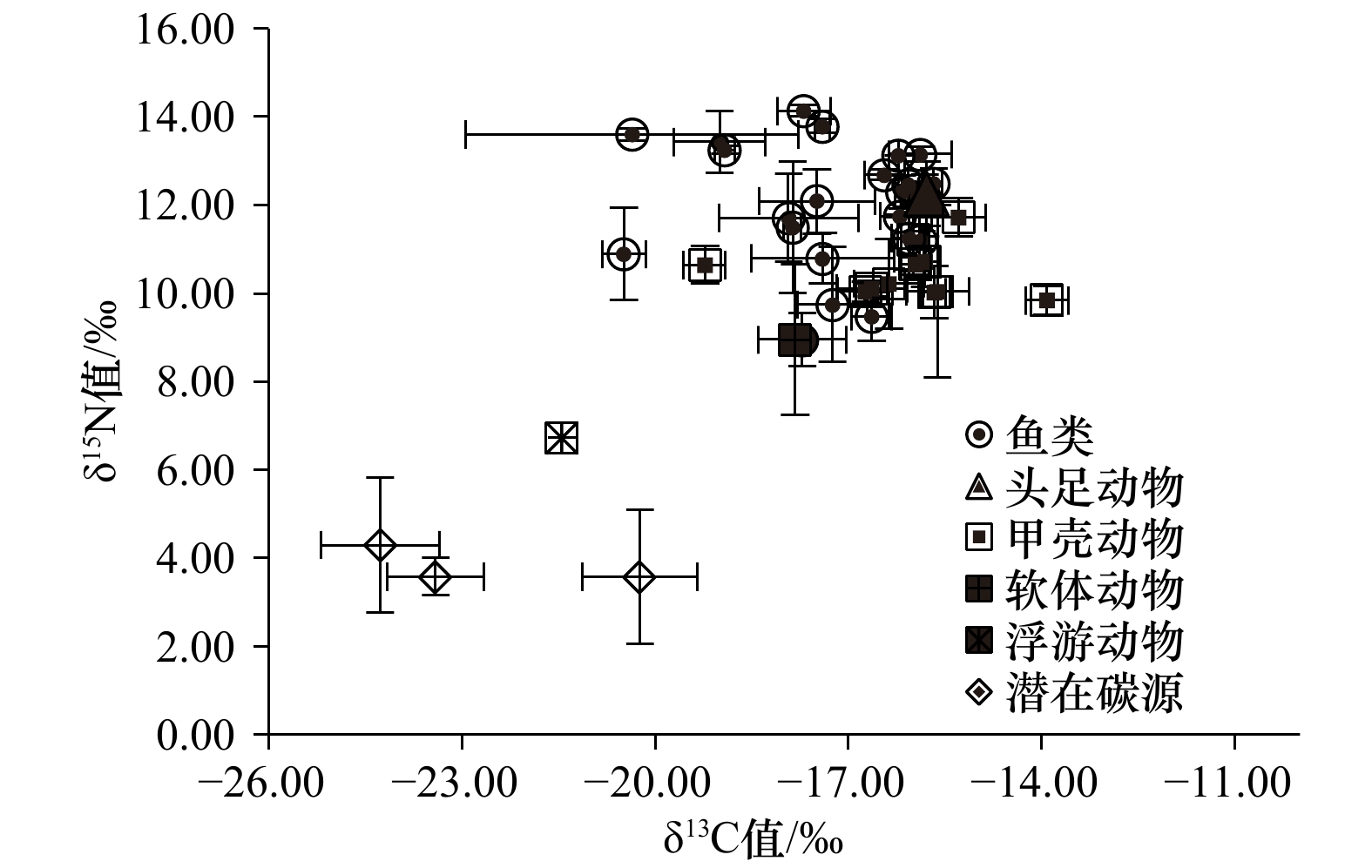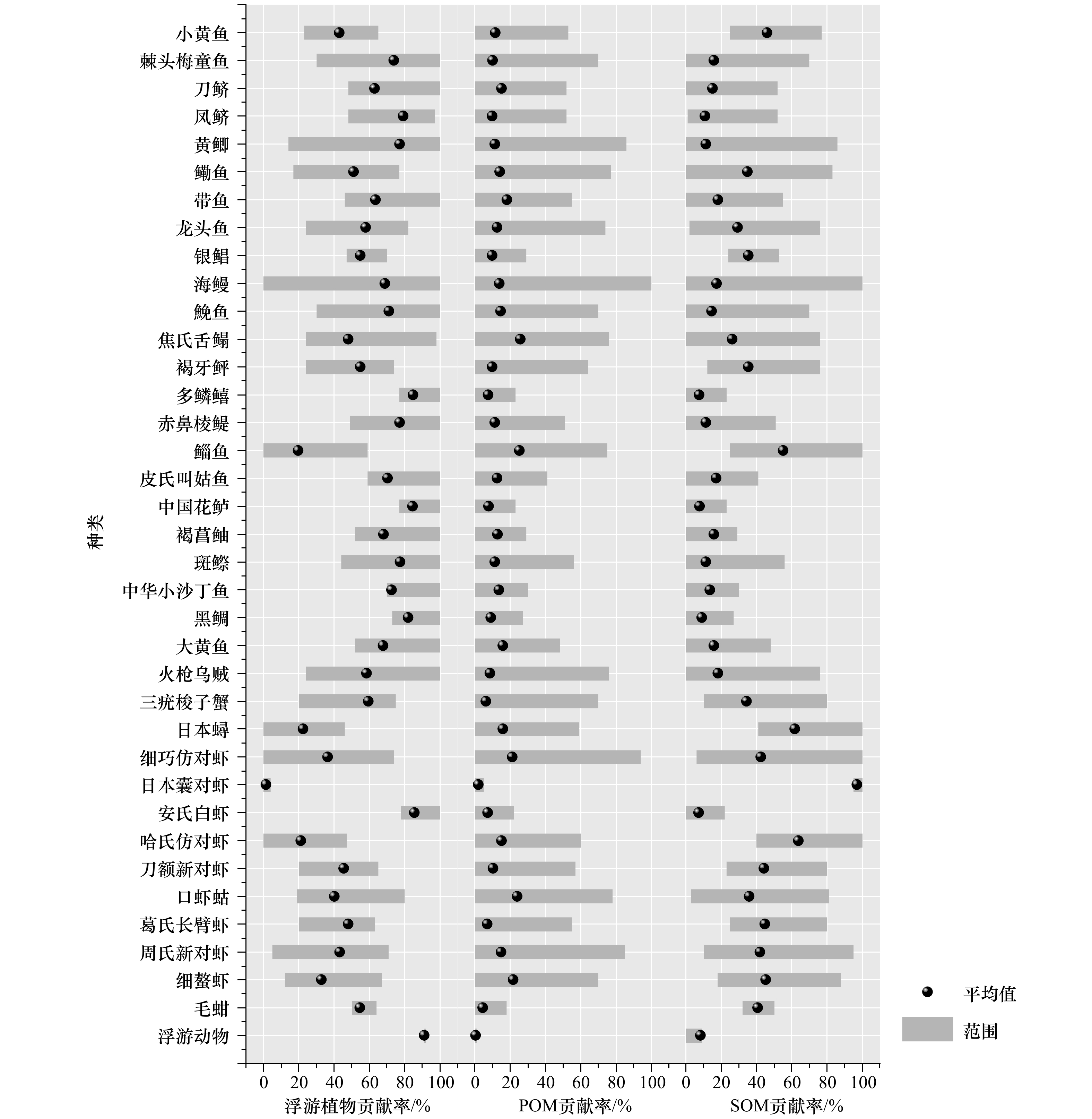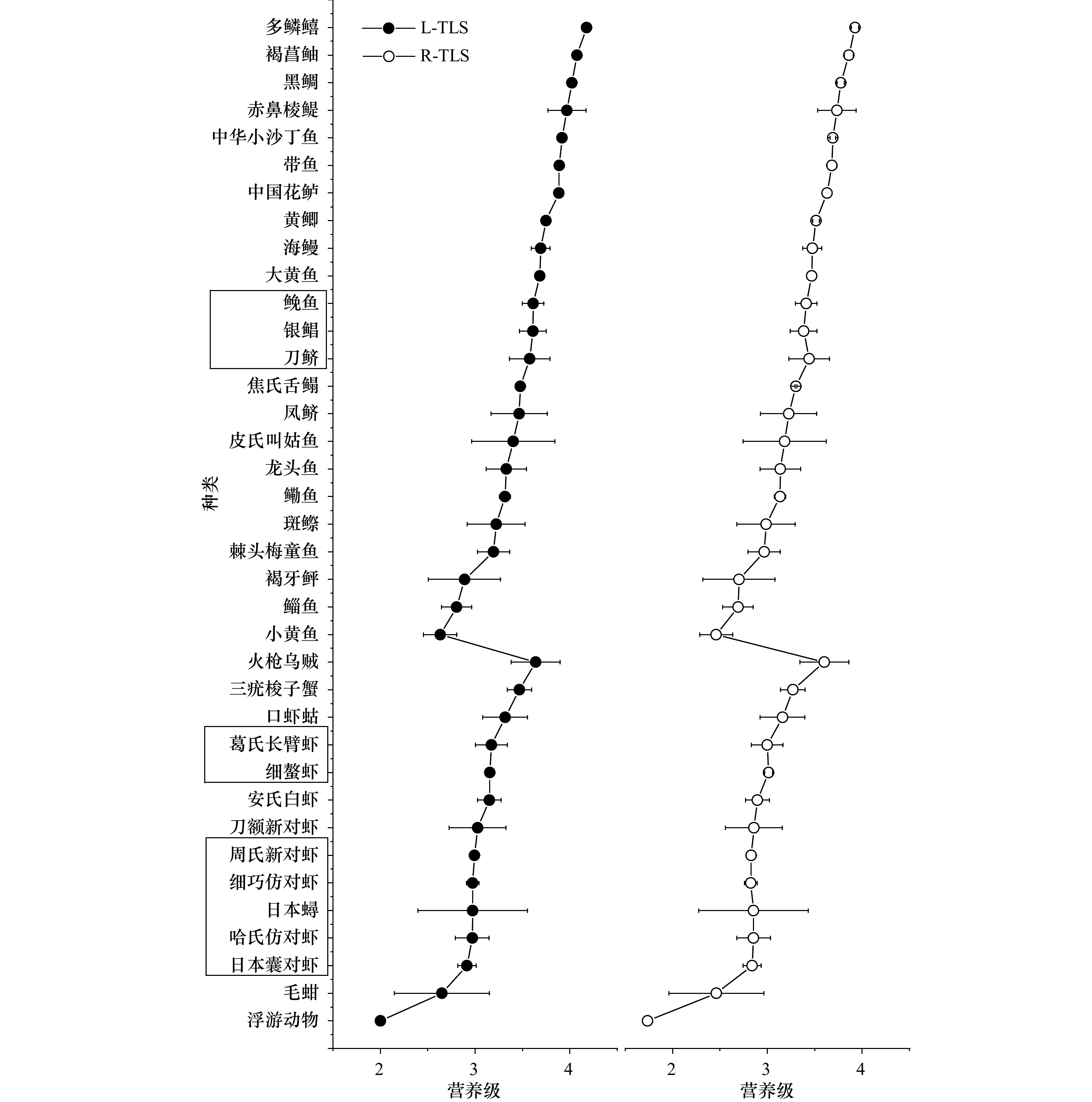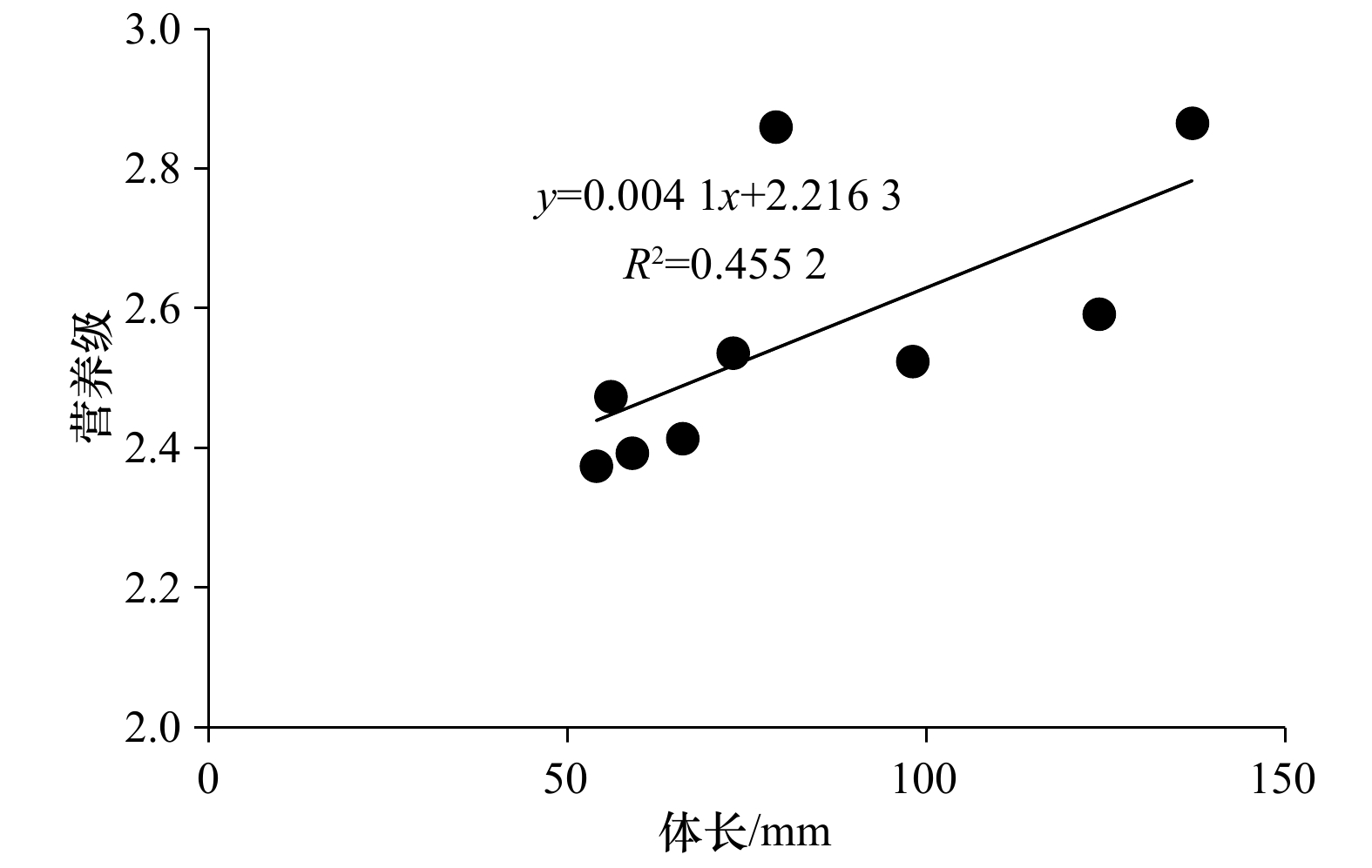The potential carbon source and trophic level analysis of main organisms in coastal water of Lüsi fishing ground, based on carbon and nitrogen stable isotope analysis
-
摘要: 基于稳定同位素方法,对2018年吕泗渔场近岸海域夏季主要生物种类的潜在碳源及其营养级进行分析,利用IsoSource模型计算该海域消费者的3大碳源(浮游植物、悬浮颗粒有机物、底质有机物)贡献值,并比较叠加潜在碳源影响前后主要生物种类的营养级变化。结果表明,浮游植物和底质有机物对37种主要生物种类的贡献比例分别为58.7%和28.2%,而悬浮颗粒有机物的贡献较小。因此判定吕泗渔场近岸海域夏季主要生物种类的潜在碳源主要是浮游植物和底质有机物。通过分别叠加3大潜在碳源和单一物种作为基准值构建两个营养级谱,右营养级谱的生物种类营养级范围为1.74~3.92,比左营养级谱平均下降0.19个营养级,尽管两个营养级谱的整体趋势走向不变,但部分鱼类和多数虾类的营养位置发生改变。右营养级谱的基准值随着潜在碳源叠加比例的不同而变化,能有效反映生物营养级,更适用于低营养级的虾蟹类。但对于处于中高级消费者位置的鱼类来说,这种叠加的效果影响不大。Abstract: Trophic level among main organisms in costal water of Lüsi fishing ground in summer, 2018, were analyzed in this study by stable isotope method. Using IsoSource model, we calculated potential carbon source contribution of the phytoplankton, POM and SOM of consumers, and then compared the former and latter TLs variation of main organisms by overlapping potential carbon source influence. Results showed that phytoplankton and SOM were main potential carbon source of main organisms in costal water of Lüsi fishing ground in summer. Two trophic level spectrums were constructed by overlapping three potential carbon sources and a single species as the baseline organisms, respectively. The trophic level of the right trophic level spectrum ranged from 1.74 to 3.92, which was averagely 0.19 lower than that of the left trophic level spectrum. Although the overall trend was unchanged, the trophic positions of some fish and most shrimps were changed in two spectrums. The baseline organisms in the right trophic level spectrum changed with the different stacking ratio of potential carbon sources, which could reflect the trophic level more effectively and was more suitable for organisms at low trophic levels, such as shrimp and crabs. However, this had little impact on fish in the position of middle and advanced consumers.
-
图 4 吕泗渔场近岸海域L-TLS(左营养级谱)和R-TLS(右营养级谱)的物种营养级比较
被框选物种在两个营养级的营养位置不同
Fig. 4 Comparison of trophic levels of species plotted by L-TLS (left trephic level spectrums) and R-TLS (right trephic level spectrums) in coastal waters of Lüsi fishing ground
The trophic position of the framed species differed between the two trophic level spectrums
表 1 吕泗渔场近岸海域生物种类、数量、体长范围和δ13C值、δ15N值
Tab. 1 The species number, body length range and δ13C, δ15N value of the samples collected in coastal water of Lüsi fishing ground
种类 体长范围/mm 数量 δ13C值/‰(平均值±标准差) δ15N值/‰(平均值±标准差) 鱼类 小黄鱼 Larimichthys polyactis 54~137 9 −17.72±0.68 8.95±0.6 棘头梅童鱼 Collichthys lucidus 100~112 4 −17.4±1.11 10.79±0.58 刀鲚 Coilia macrognathos 175~305 6 −17.49±0.9 12.09±0.73 凤鲚 Coilia mystus 110~180 4 −17.93±1.08 11.71±1.01 黄鲫 Setipinna taty 125~170 4 −16.44±0.31 12.68±0.12 鳓鱼 Ilisha elongata 136~160 3 −15.87±0.03 11.2±0.2 带鱼 Trichiurus japonicus 359~625 2 −15.88±0.49 13.15±0.17 龙头鱼 Harpadon nehereus 195~201 3 −16.06±0.27 11.25±0.72 银鲳 Pampus argenteus 104~131 3 −15.82±0.1 12.2±0.48 海鳗 Muraenesox cinereus 478~588 3 −15.68±0.13 12.49±0.34 鮸鱼 Miichthys miiuy 234~320 5 −16.17±0.11 12.29±0.37 焦氏舌鳎 Cynoglossus joyneri 142~200 2 −16.2±0.31 11.75±0.03 褐牙鲆 Paralichthys olivaceus 85 3 −17.25±0.54 9.75±1.3 多鳞鱚 Sillago sihama 176~179 2 −17.69±0.41 14.13±0.13 赤鼻棱鳀 Thryssa kammalensis 85~101 4 −19±0.71 13.43±0.69 鲻鱼 Mugil cephalus 139~149 2 −16.64±0.32 9.47±0.55 皮氏叫姑鱼 Johnius belangerii 87~111 2 −17.87±0.13 11.5±1.49 中国花鲈 Lateolabrax maculatus 170 1 −16.22±0 13.13±0 褐菖鲉 Sebastiscus marmoratus 122~148 3 −17.4±0.11 13.79±0.16 斑鰶 Konosirus punctatus 160~194 3 −20.49±0.34 10.89±1.04 中华小沙丁鱼 Sardinella nymphaea 99~103 2 −18.92±0.16 13.25±0.1 黑鲷 Acanthopagrus schlegelii 164~169 2 −20.36±2.58 13.6±0.13 大黄鱼 Larimichthys crocea 171 1 −16.07±0 12.45±0 头足动物 火枪乌贼 Loligo beka 126~194 3 −15.79±0.17 12.25±0.73 甲壳动物 三疣梭子蟹 Portunus trituberculatus 90~172 4 −15.29±0.42 11.72±0.44 日本蟳 Charybdis japonica 61~70 3 −15.62±0.49 10.04±1.96 细巧仿对虾 Parapenaeopsis tenella 49~52 3 −16.74±0.43 10.04±0.23 日本囊对虾 Marsupenaeus japonicus 106~112 2 −13.92±0.33 9.84±0.33 安氏白虾 Exopalaemon annandalei 75~82 3 −19.23±0.32 10.64±0.43 哈氏仿对虾 Parapenaeopsis hardwickii 84~110 5 −15.67±0.18 10.03±0.6 刀额新对虾 Metapenaeus ensi 74~80 4 −16.37±0.54 10.22±1.02 口虾蛄 Oratosquilla oratoria 125~180 3 −15.99±0.19 11.21±0.8 葛氏长臂虾 Palaemon gravieri 60~68 3 −15.81±0.19 10.72±0.57 周氏新对虾 Metapenaeus joyneri 90~120 5 −16.64±0.55 10.11±0.18 细螯虾 Leptochela gracilis 70~75 2 −15.96±0.22 10.66±0.15 软体动物 毛蚶 Scapharca subcrenata 25~29 2 −17.83±0 8.94±1.71 浮游动物 浮游动物 1 −21.45±0 6.73±0 潜在碳源 浮游植物 11 −24.27±0.92 4.3±1.53 悬浮颗粒有机物 12 −23.41±0.75 3.58±0.42 底质有机物 11 −20.24±0.89 3.58±1.52 表 2 潜在碳源δ13C和δ15N的值
Tab. 2 Values of δ13C and δ15N for the potential carbon sources
分类 数量 δ13C值/‰ δ15N值/‰ 浮游植物 11 −24.27±0.92 4.3±1.53 POM 12 −23.41±0.75 3.58±0.42 SOM 11 −20.24±0.89 3.58±1.52 -
[1] Kaehler S, Pakhomov E A, Mcquaid C D. Trophic structure of the marine food web at the Prince Edward Islands (Southern Ocean) determined by δ13C and δ15N analysis[J]. Marine Ecology Progress Series, 2000, 208: 13−20. doi: 10.3354/meps208013 [2] Frederiksen M, Edwards M, Richardson A J, et al. From plankton to top predators: bottom-up control of a marine food web across four trophic levels[J]. Journal of Animal Ecology, 2006, 75(6): 1259−1268. doi: 10.1111/j.1365-2656.2006.01148.x [3] Duffy J E, Cardinale B J, France K E, et al. The functional role of biodiversity in ecosystems: incorporating trophic complexity[J]. Ecology Letters, 2007, 10(6): 522−538. doi: 10.1111/j.1461-0248.2007.01037.x [4] Cortés E. A critical review of methods of studying fish feeding based on analysis of stomach contents: application to elasmobranch fishes[J]. Canadian Journal of Fisheries and Aquatic Sciences, 1997, 54(3): 726−738. doi: 10.1139/f96-316 [5] Zanden M J V, Rasmussen J B. Primary consumer δ13C and δ15N and the trophic position of aquatic consumers[J]. Ecology, 1999, 80(4): 1395−1404. doi: 10.1890/0012-9658(1999)080[1395:PCCANA]2.0.CO;2 [6] Jennings S, Greenstreet S, Hill L, et al. Long-term trends in the trophic structure of the North Sea fish community: evidence from stable-isotope analysis, size-spectra and community metrics[J]. Marine Biology, 2002, 141(6): 1085−1097. doi: 10.1007/s00227-002-0905-7 [7] Hadwen W L, Russell G L, Arthington A H. Gut content- and stable isotope-derived diets of four commercially and recreationally important fish species in two intermittently open estuaries[J]. Marine and Freshwater Research, 2007, 58(4): 363−375. doi: 10.1071/MF06157 [8] Christianen M J A, Middelburg J J, Holthuijsen S J, et al. Benthic primary producers are key to sustain the Wadden Sea food web: stable carbon isotope analysis at landscape scale[J]. Ecology, 2017, 98(6): 1498−1512. doi: 10.1002/ecy.1837 [9] Peterson B J, Fry B. Stable isotopes in ecosystem studies[J]. Annual Review of Ecology and Systematics, 1987, 18: 293−320. doi: 10.1146/annurev.es.18.110187.001453 [10] Raffaelli D. Nutrient enrichment and trophic organisation in an estuarine food web[J]. Acta Oecologica, 1999, 20(4): 449−461. doi: 10.1016/S1146-609X(99)00123-X [11] Post D M. Using stable isotopes to estimate trophic position: models, methods, and assumptions[J]. Ecology, 2002, 83(3): 703−718. doi: 10.1890/0012-9658(2002)083[0703:USITET]2.0.CO;2 [12] 蔡德陵, 李红燕, 唐启升, 等. 黄东海生态系统食物网连续营养谱的建立: 来自碳氮稳定同位素方法的结果[J]. 中国科学: C辑, 2005, 48(6): 531−539. doi: 10.1360/04yc0136Cai Deling, Li Hongyan, Tang Qisheng, et al. Establishment of trophic continuum in the food web of the Yellow Sea and East China Sea ecosystem: Insight from carbon and nitrogen stable isotopes[J]. Science in China Series C: Life Sciences, 2005, 48(6): 531−539. doi: 10.1360/04yc0136 [13] Hussey N E, Macneil M A, McMeans B C, et al. Rescaling the trophic structure of marine food webs[J]. Ecology Letters, 2014, 17(2): 239−250. doi: 10.1111/ele.12226 [14] Qu Pei, Wang Qixiang, Pang Min, et al. Trophic structure of common marine species in the Bohai Strait, North China Sea, based on carbon and nitrogen stable isotope ratios[J]. Ecological Indicators, 2016, 66: 405−415. doi: 10.1016/j.ecolind.2016.01.036 [15] 麻秋云, 韩东燕, 刘贺, 等. 应用稳定同位素技术构建胶州湾食物网的连续营养谱[J]. 生态学报, 2015, 35(21): 7207−7218.Ma Qiuyun, Han Dongyan, Liu He, et al. Construction of a continuous trophic spectrum for the food web in Jiaozhou Bay using stable isotope analyses[J]. Acta Ecologica Sinica, 2015, 35(21): 7207−7218. [16] 中华人民共和国国家质量监督检验检疫总局, 中国国家标准化管理委员会. GB/T 12763.6—2007, 海洋调查规范 第6部分: 海洋生物调查[S]. 北京: 中国标准出版社, 2008.General Administration of Quality Supervision, Inspection and Quarantine of the People’s Republic of China, Standardization Administration. GB/T 12763.6—2007, Specifications for oceanographic survey—Part 6: marine biological survey[S]. Beijing: Standards Press of China, 2008. [17] Jacob U, Mintenbeck K, Brey T, et al. Stable isotope food web studies: a case for standardized sample treatment[J]. Marine Ecology Progress Series, 2005, 287: 251−253. doi: 10.3354/meps287251 [18] Phillips D L, Gregg J W. Source partitioning using stable isotopes: coping with too many sources[J]. Oecologia, 2003, 136(2): 261−269. doi: 10.1007/s00442-003-1218-3 [19] Bănaru D, Harmelin-Vivien M. Trophic links and riverine effects on food webs of pelagic fish of the north-western Black Sea[J]. Marine and Freshwater Research, 2009, 60(6): 592−540. [20] Caut S, Angulo E, Courchamp F. Variation in discrimination factors ( $ \Delta $ 15N and$ \Delta $ 13C): the effect of diet isotopic values and applications for diet reconstruction[J]. Journal of Applied Ecology, 2009, 46(2): 443−453. doi: 10.1111/j.1365-2664.2009.01620.x[21] Plass-Johnson J G, McQuaid C D, Hill J M. Stable isotope analysis indicates a lack of inter- and intra-specific dietary redundancy among ecologically important coral reef fishes[J]. Coral Reefs, 2013, 32(2): 429−440. doi: 10.1007/s00338-012-0988-7 [22] Weitere M, Scherwass A, Sieben K T, et al. Planktonic food web structure and potential carbon flow in the lower river rhine with a focus on the role of protozoans[J]. River Research and Applications, 2005, 21(5): 535−549. doi: 10.1002/rra.825 [23] Heyng A M, Mayr C, Lücke A, et al. Late Holocene hydrologic changes in northern New Zealand inferred from stable isotope values of aquatic cellulose in sediments from Lake Pupuke[J]. Journal of Paleolimnology, 2014, 51(4): 485−497. doi: 10.1007/s10933-014-9769-3 [24] 孙明, 王彬, 李玉龙, 等. 基于碳氮稳定同位素技术研究辽东湾海蜇的食性和营养级[J]. 应用生态学报, 2016, 27(4): 1103−1108.Sun Ming, Wang Bin, Li Yulong, et al. Feeding habitats and trophic levels of Rhopilema esculentum Kishinouye in Liaodong Bay based on analyzing carbon and nitrogen stable isotopes[J]. Chinese Journal of Applied Ecology, 2016, 27(4): 1103−1108. [25] Gillikin P D, Lorrain A, Bouillon S, et al. Stable carbon isotopic composition of Mytilus edulis shells: relation to metabolism, salinity, δ13CDIC and phytoplankton[J]. Organic Geochemistry, 2006, 37(10): 1371−1382. doi: 10.1016/j.orggeochem.2006.03.008 [26] 蔡德陵, 孟凡, 韩贻兵, 等. 13C/12C比值作为海洋生态系统食物网示踪剂的研究——崂山湾水体生物食物网的营养关系[J]. 海洋与湖沼, 1999, 30(6): 671−678. doi: 10.3321/j.issn:0029-814X.1999.06.015Cai Deling, Meng Fan, Han Yibing, et al. Studies on 13C/12C ratios as a tracer for food web in a marine ecosystem—the trophic relations in pelagic food webs in Laoshan Bay[J]. Oceanologia et Limnologia Sinica, 1999, 30(6): 671−678. doi: 10.3321/j.issn:0029-814X.1999.06.015 [27] 魏虎进, 朱小明, 纪雅宁, 等. 基于稳定同位素技术的象山港海洋牧场区食物网基础与营养级的研究[J]. 应用海洋学学报, 2013, 32(2): 250−257. doi: 10.3969/J.ISSN.2095-4972.2013.02.015Wei Hujin, Zhu Xiaoming, Ji Yaning, et al. Study on the food web structure and their trophic levels of marine ranching area in Xiangshan Harbor[J]. Journal of Applied Oceanography, 2013, 32(2): 250−257. doi: 10.3969/J.ISSN.2095-4972.2013.02.015 [28] 谢斌, 李云凯, 张虎, 等. 基于稳定同位素技术的海州湾海洋牧场食物网基础及营养结构的季节性变化[J]. 应用生态学报, 2017, 28(7): 2292−2298.Xie Bin, Li Yunkai, Zhang Hu, et al. Food web foundation and seasonal variation of trophic structure based on the stable isotopic technique in the marine ranching of Haizhou Bay, China[J]. Chinese Journal of Applied Ecology, 2017, 28(7): 2292−2298. [29] Mintenbeck K, Jacob U, Knust R, et al. Depth-dependence in stable isotope ratio δ15N of benthic POM consumers: the role of particle dynamics and organism trophic guild[J]. Deep-Sea Research Part I: Oceanographic Research Papers, 2007, 54(6): 1015−1023. doi: 10.1016/j.dsr.2007.03.005 [30] Xu J, Lü H, Xu X, et al. Dual stable isotope tracing the source and composition of POM during algae blooms in a large and shallow eutrophic lake: All contributions from algae?[J]. Ecological Indicators, 2019, 102(7): 599−607. [31] Romanuk T N, Hayward A, Hutchings J A. Trophic level scales positively with body size in fishes[J]. Global Ecology and Biogeography, 2011, 20(2): 231−240. doi: 10.1111/j.1466-8238.2010.00579.x [32] Xue Y, Jin X, Zhang B, et al. Seasonal, diel and ontogenetic variation in feeding patterns of small yellow croaker in the central Yellow Sea[J]. Journal of Fish Biology, 2005, 67(1): 33−50. doi: 10.1111/j.0022-1112.2005.00677.x [33] Ji Weiwei, Chen Xuezhong, Jiang Yazhou, et al. Trophic ecology of small yellow croaker (Larimichthys polyactis Bleeker): stable carbon and nitrogen isotope evidence[J]. Chinese Journal of Oceanology and Limnology, 2011, 29(5): 1033−1040. doi: 10.1007/s00343-011-0188-2 [34] 贡艺, 陈玲, 李云凯. 海洋生态系统稳定同位素基线的选取[J]. 应用生态学报, 2017, 28(7): 2399−2404.Gong Yi, Chen Ling, Li Yunkai. Selection of isotopic baselines in marine ecosystem[J]. Chinese Journal of Applied Ecology, 2017, 28(7): 2399−2404. [35] 闫光松, 张涛, 赵峰, 等. 基于稳定同位素技术对长江口主要渔业生物营养级的研究[J]. 生态学杂志, 2016, 35(11): 3131−3136.Yan Guangsong, Zhang Tao, Zhao Feng, et al. A study on trophic level of the major fishery species from the Yangtze Estuary based on stable isotope technology[J]. Chinese Journal of Ecology, 2016, 35(11): 3131−3136. [36] Valls M, Olivar M P, De Puelles M L F, et al. Trophic structure of mesopelagic fishes in the western Mediterranean based on stable isotopes of carbon and nitrogen[J]. Journal of Marine Systems, 2014, 138: 160−170. doi: 10.1016/j.jmarsys.2014.04.007 [37] Vinagre C, Salgado J P, Mendonça V, et al. Isotopes reveal fluctuation in trophic levels of estuarine organisms, in space and time[J]. Journal of Sea Research, 2012, 72: 49−54. doi: 10.1016/j.seares.2012.05.010 [38] Du J G, Cheung W W L, Zheng X Q, et al. Comparing trophic structure of a subtropical bay as estimated from mass-balance food web model and stable isotope analysis[J]. Ecological Modelling, 2015, 312: 175−181. doi: 10.1016/j.ecolmodel.2015.05.027 [39] 刘海林, 仲霞铭, 汤建华, 等. 江苏近海鱼类群落组成和多样性的季节变化[J]. 海洋渔业, 2017, 39(1): 9−20. doi: 10.3969/j.issn.1004-2490.2017.01.002Liu Hailin, Zhong Xiaming, Tang Jianhua, et al. Seasonal changes of fish community composition and diversity in the offshore waters of Jiangsu[J]. Marine Fisheries, 2017, 39(1): 9−20. doi: 10.3969/j.issn.1004-2490.2017.01.002 -




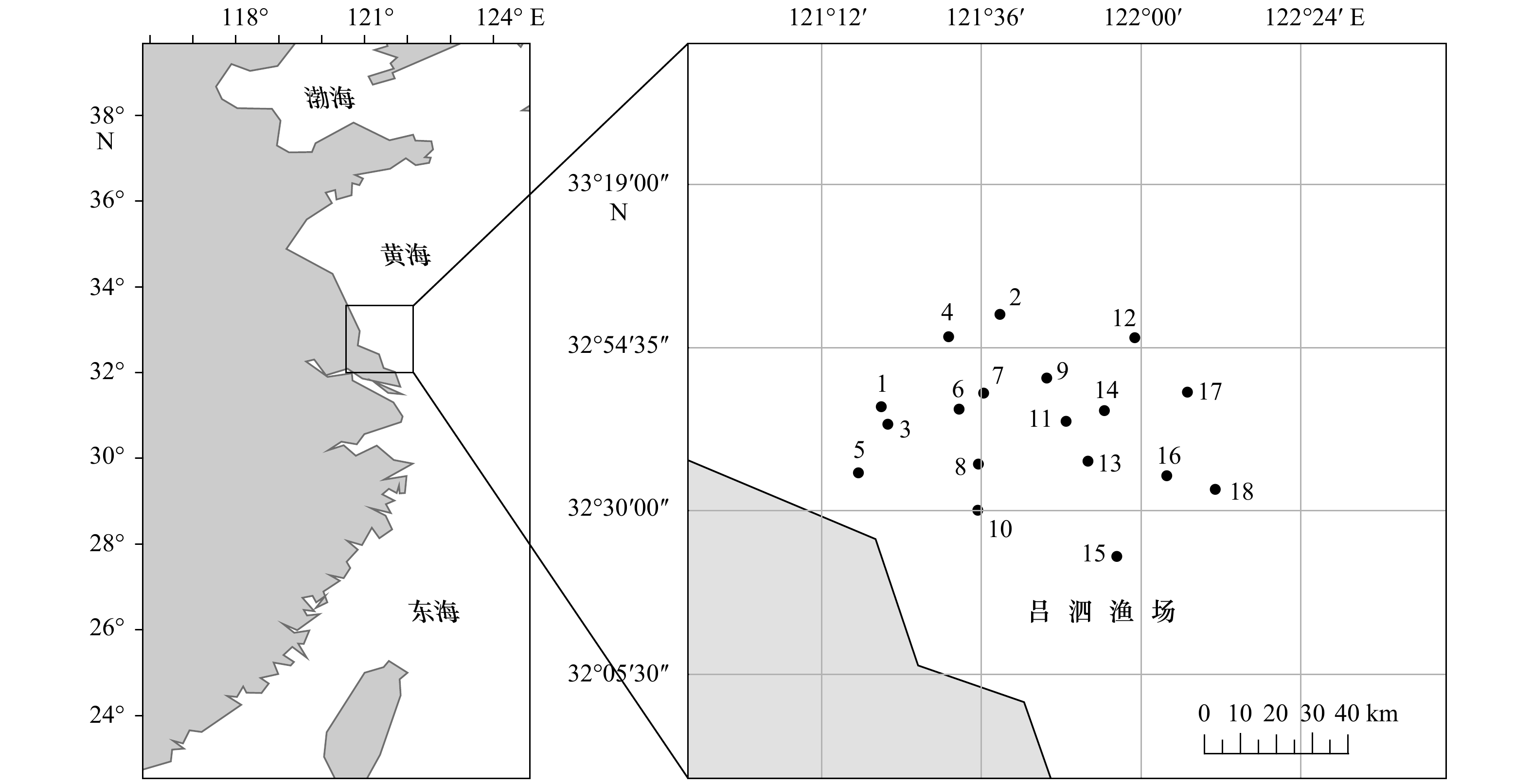
 下载:
下载:
